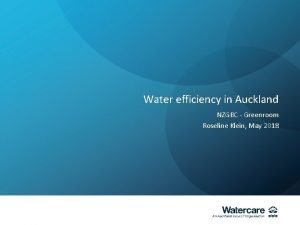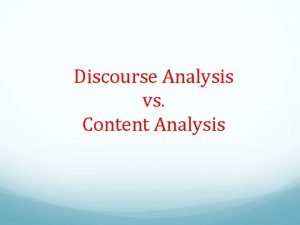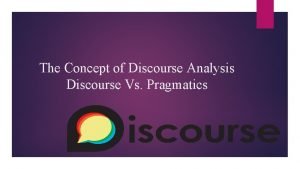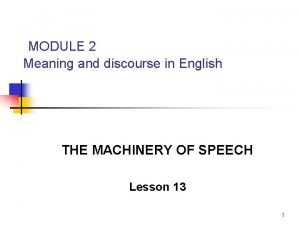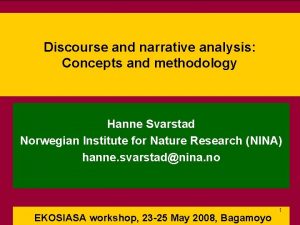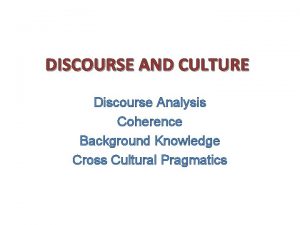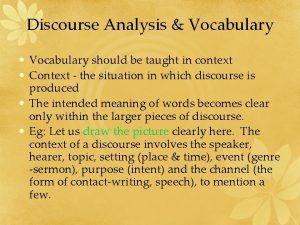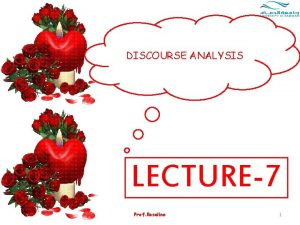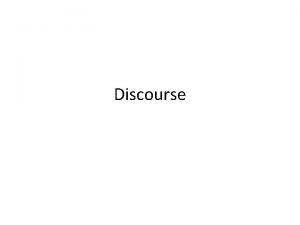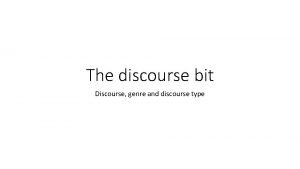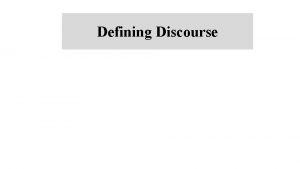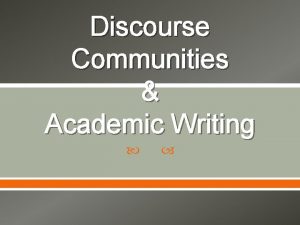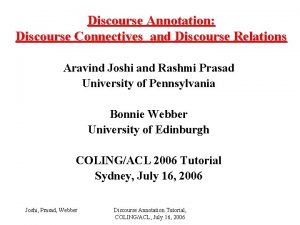DISCOURSE ANALYSIS LECTURE7 Prof Roseline 1 Discourse Analysis










- Slides: 10

DISCOURSE ANALYSIS LECTURE-7 Prof. Roseline 1

Discourse Analysis Discourse analysis is sometimes defined as the analysis of language 'beyond the sentence'. Discourse analysts study larger chunks of language as they flow together. Trains collide, two die, - know that what happened in the first part was the cause of what happened in the second part. No shoes, no service, on shop windows in summer understanding that a conditional relation exists between the two parts (“If you are wearing no shoes, you will receive no service”). - have the ability to create complex discourse interpretations of fragmentary linguistic messages. Prof. Roseline 2

Interpreting Discourse My Town My natal was in a small town, very close to Riyadh capital of Saudi Arabia. The distant between my town and Riyadh 7 miles exactly. The name of this Almasani that means in English Factories. It takes this name from the people’s carrer. In my childhood I remmeber the people live. It was very simple. Most the people was farmer. a simple point about the way we react to language that contains ungrammatical forms. Rather than simply reject the text as ungrammatical, we try to make sense of it. we attempt to arrive at a reasonable interpretation of what the writer intended to convey COHESION Texts must have a certain structure that depends on factors quite different from those required in the structure of a single sentence The ties and connections that exist within texts My father once bought a Lincoln convertible. He did it by saving every penny he could. That car would be worth a fortune nowadays. However, he sold it to help pay for my college education. Sometimes I think I’d rather have the convertible. An appropriate number of cohesive ties may be a crucial factor in our judgments on whether something is well written or not Prof. Roseline 3

COHERENCE the connections that interpretation of texts create a meaningful Interpretation of normal texts is not simply based on connections between the words. There must be some other factor that leads us to distinguish connected texts that make sense from those that do not. This factor is usually described as ‘coherence’. SPEECH EVENTS To know about taking part in conversation, or any other speech event (e. g. debate, interview, various types of discussions), For example, to specify the roles of speaker and hearer (or hearers) and their relationship(s), Conversation Analysis conversation can be described as an activity in which, for the most part, two or more people take turns at speaking. in conversation, the unit of talk by one speaker, ended by the beginning of the next speaker’s unit of talk COMPLETION POINT in conversation, the end of a turn, usually marked by a pause at the end of a phrase or sentence Prof. Roseline 4

TURN-TAKING The way in which each speaker takes a turn in conversation The participants characterized as ‘rude’ or ‘shy’ in this way may simply be adhering to slightly different conventions of turntaking. Turn taking is the back-and-forth interaction needed to have a conversation. FILLED PAUSE: a break in the flow of speech, using sounds such as em and er THE CO-OPERATIVE PRINCIPLE An underlying assumption of conversation that you will “make your conversational contribution such as is required, at the stage at which it occurs, by the accepted purpose or direction of the talk exchange in which you are engaged” Make your conversational contribution such as is required, at the stage at which it occurs, by the accepted purpose or direction of the talk exchange in which you are engaged” (Grice, 1975: 45). Supporting this principle are four maxims, often called the “Gricean maxims. ” COMMUNICATIVE PRINCIPLES Prof. Roseline 5

THE CO-OPERATIVE PRINCIPLE The quantity maxim The quality maxim The relation maxim The manner maxim Hedges Make your contribution as informative as is required, but not more, or less, than is required. Do not say that which you believe to be false or for which you lack adequate evidence. Be relevant. Be clear, brief and orderly. A word or phrase used to indicate that you are not really sure that what you are saying is sufficiently correct or complete Hedges can be used to show on the accuracy of our statements, as in descriptions such as His hair was kind of long or The book cover is sort of yellow (rather than It is yellow). Examples of hedges on the Quality maxim Prof. Roseline 6

Implicatures An additional meaning conveyed by a speaker adhering to the cooperative principle How people actually decide that someone is ‘implying’ something in conversation. Jane : Are you coming to the party tonight? Joe : I’ve got an exam tomorrow. BACKGROUND KNOWLEDGE Example John was on his way to school last Friday. He was really worried about the math lesson Background information serves the same purpose in research. It is the foundation on which you build good research. Why is background information important? It helps you to focus on names, dates, events, organizations, terms, etc. , associated with a topic. It can help you to formulate/reformulate your topic (or, to put it another way, it can help you decide whether to broaden or narrow your topic). Background sources might include bibliographies that you can use to find additional sources for your project. Prof. Roseline 7

SCHEMAS A schema is a general term for a conventional knowledge structure that exists in memory. (food is displayed on shelves, arranged in aisles, etc. ) A schema is a cognitive framework or concept that helps organize and interpret information. Schemas can be useful, because they allow us to take shortcuts in interpreting a vast amount of information. However, these mental frameworks also cause us to exclude pertinent information in favor of information that confirms our pre-existing beliefs and ideas. Schemas can contribute to stereotypes and make it difficult to retain new information that does not conform to our established schemas. Prof. Roseline 8

SCRIPTS Similar in many ways to a schema is a script. A script is essentially a dynamic schema. A script has a series of conventional actions that take place “Eating in a restaurant” script, - activated to make sense of this short text Trying not to be out of the office for long, Suzy went into the nearest place, sat down and ordered an avocado sandwich. It was quite crowded, but the service was fast, so she left a good tip. Back in the office, things were not going well Able to say a number of things about the scene and events briefly described in this short text. The fact that information of this type can turn up in people’s attempts to remember the text is further evidence of the existence of scripts. Prof. Roseline 9

THANK YOU Prof. Roseline 10
 Roseline klein
Roseline klein Roseline gagnon naturopathe
Roseline gagnon naturopathe What is discourse analysis
What is discourse analysis Content vs discourse analysis
Content vs discourse analysis The role of context in discourse analysis
The role of context in discourse analysis Difference between pragmatics and discourse analysis
Difference between pragmatics and discourse analysis Module 2 meaning
Module 2 meaning Informativity in text linguistics
Informativity in text linguistics What is discourse
What is discourse Cultural discourse analysis
Cultural discourse analysis Register and signaling vocabulary
Register and signaling vocabulary
